
DR.
J'S ILLUSTRATED LECTURES
The
Illustrated Mythic Hero
Illustrated Greek Theater
Illustrated Greek Drama
Illustrated Parthenon Marbles
Illustrated Road to the Recovery of
Ancient Buildings
Illustrated Greek History MENU
Bronze Age
Archaic Age
Persian Wars
Classical Age
|
 |
| Dr. J's
Illustrated Persian Wars |
| The Classical Age begins with the
monumental Greek victory over the Persians in what have become known to us as the Persian
Wars. Pericles makes reference to these wars when he boasts about the previous generation
of Athenians' success in "stemming the tide of foreign aggression." The Persian
Wars were really a series of Persian versus Greek battles, in which Greek citizens from
many city-states fought against the barbarian (as they saw it) invaders. The Persian Wars
are said to have been provoked by the gradual rejection of Persian authority by the Greek
colonies along the Ionian coast (across the Aegean Sea from Athens, on the shore of the
continent of Asia) from 499-494 BC. Living in the shadow of the Persian Empire, and
tired of paying tribute, some of the colonies (founded during the Archaic period during
the Age of Expansion/Colonization) tried flexing their muscles and were immediately and
utterly trounced by the much more formidable Persians. Once the Persians invaded
Eretria,
one of the big naysayers, and enslaved her population, Athens (Persia's next target) knew
that trouble was coming down the pike and prepared as best she could... |
The
Battle Of Marathon (490 BC) |
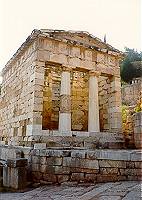 Herodotus assures us that the Greek victory
that stunned both sides was the result of a shrewd battleplan: the great Athenian general
Miltiades chose not to deploy his troops in the traditional way, with the bulk of his men
in the middle of a phalanx of soldiers. Instead, he thinned out the ranks in the center,
giving the Persians a false sense of imminent victory. After the Persians easily broke
through the ranks, they were swarmed by Greek soldiers attacking from the flanks
(Athenians from one side and Plataeans from the other). Herodotus also tells us that for
the first time Athenian slaves were freed so that they could fight for the Athenian cause.
After the battle, the Athenians built this treasury (photo upper left) at Delphi to hold
all their votive offerings to the oracle. Herodotus assures us that the Greek victory
that stunned both sides was the result of a shrewd battleplan: the great Athenian general
Miltiades chose not to deploy his troops in the traditional way, with the bulk of his men
in the middle of a phalanx of soldiers. Instead, he thinned out the ranks in the center,
giving the Persians a false sense of imminent victory. After the Persians easily broke
through the ranks, they were swarmed by Greek soldiers attacking from the flanks
(Athenians from one side and Plataeans from the other). Herodotus also tells us that for
the first time Athenian slaves were freed so that they could fight for the Athenian cause.
After the battle, the Athenians built this treasury (photo upper left) at Delphi to hold
all their votive offerings to the oracle.The Battle of Marathon spawned legends immediately: witnesses
swore that the ghost of Theseus (mythical king of Athens) loomed over the field, giving
confidence to his countrymen; the messenger Phidippides is said to have run into the god
Pan on his way to ask for help from the Spartans and received the god's help instead (and
too, the old story about how he died after running the equivalent of 26 miles to deliver
news of the victory at Marathon is not supported by any ancient source...); and some say
that the clash of arms can still be heard today on the Plain of Marathon at night.
The story of a victory run from Marathon to Athens first appears in
Plutarch's Moralia (347C) over half a millennium later than the Persian Wars;
he gives credit to either Thersippus or Eukles. Lucian, in the second
century AD, says that a PhiLippides ran from Marathon.
The story is probably a confused version of the even more astounding run
that Herodotus tells us PhiDippides completed from Athens to Sparta just
BEFORE the battle. He went to seek Spartan aid and took 2 days to run the
145 miles between the two cities -- an impressive, but not unbelievable feat
(Hdt. 6.105-6) |
| Pausanias (1.33.2) tells us that
the Persians were so sure of victory that they had brought with them a block of marble to
be carved into a victory monument. Instead, the great Athenian sculptor Pheidias carved it
into a statue of the god Nemesis, avenger of wicked actions, plainly indicating that the
Persians got exactly what they deserved. See Book 6 of Herodotus' History
for a full report on the 490 BC Battle of Marathon. |
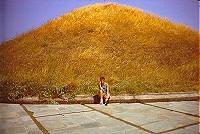 On the left is
the soros on site at Marathon, the burial place for the 192
Athenian soldiers who died fighting the Persians in the battle. Schliemann originally
incorrectly dated this site to the Bronze Age (an actual Bronze Age
tholos does lie very close by). But later Greek archaeological excavations confirmed
this to be the grave mound known from classical tradition. They determined that an
artificial floor 85 feet long was constructed for the purpose of a mass cremation,
followed by animal sacrifices and a funeral banquet, remains of which have also been
found. The mound (eroded from its original 14 meters to its present height of only 9 On the left is
the soros on site at Marathon, the burial place for the 192
Athenian soldiers who died fighting the Persians in the battle. Schliemann originally
incorrectly dated this site to the Bronze Age (an actual Bronze Age
tholos does lie very close by). But later Greek archaeological excavations confirmed
this to be the grave mound known from classical tradition. They determined that an
artificial floor 85 feet long was constructed for the purpose of a mass cremation,
followed by animal sacrifices and a funeral banquet, remains of which have also been
found. The mound (eroded from its original 14 meters to its present height of only 9 meters) was then heaped on top. Pausanias comments that even in his day
(2nd century AD) the men who died at Marathon were worshipped as heroes. A modern
reconstruction of the ancient memorial listing the names of the dead by tribe is on
display as well (right). meters) was then heaped on top. Pausanias comments that even in his day
(2nd century AD) the men who died at Marathon were worshipped as heroes. A modern
reconstruction of the ancient memorial listing the names of the dead by tribe is on
display as well (right). Because
the small city of Plataea had sent their entire fighting force (1000 men) to help Athens
in their stand-off against the Persians at Marathon, their dead, too, were honored with a
tomb on site. Near the soros, another tumulus stands 4 meters
tall and spans 30 meters in diameter: the Tomb of the Plataeans. Marinatos' 1970
excavations uncovered 11 burials: 8 inhumations (skeleton burials, 2 of which are pictured
below), 2 cremations and 1 pithos-burial (a child, probably a later addition).
|
An
Interlude:
Athenian Silver Strike at Laurion (483 BC) |
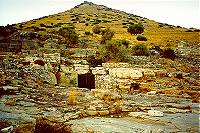 Nobody was
surprised that the Greeks won the Battle of Marathon more than the Greeks. They reveled in
their victory - especially the Athenians, who almost single-handedly had achieved the
victory (since the Spartans arrived too late to help and the Plataeans only helped bolster
the Greek line). And when everything was going along so well, things got even better - in
483 BC, the Athenians struck a rich vein of silver in one of their mines in Laurion (near
Sounion). The photo on the left shows one of Pericles' silver mines, in use since Mycenean
times. Nobody was
surprised that the Greeks won the Battle of Marathon more than the Greeks. They reveled in
their victory - especially the Athenians, who almost single-handedly had achieved the
victory (since the Spartans arrived too late to help and the Plataeans only helped bolster
the Greek line). And when everything was going along so well, things got even better - in
483 BC, the Athenians struck a rich vein of silver in one of their mines in Laurion (near
Sounion). The photo on the left shows one of Pericles' silver mines, in use since Mycenean
times.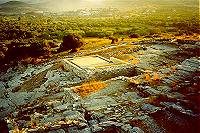 Once mined, the silver ore was placed in
a vat and washed: it is easy to screen the silver out this way, since dirt is lighter than
silver, and silver lighter than lead. The photo on the right shows a reconstructed ore
washer. Go here for
a more detailed explanation of Athenian silver mining by Andrew Wilson. Once mined, the silver ore was placed in
a vat and washed: it is easy to screen the silver out this way, since dirt is lighter than
silver, and silver lighter than lead. The photo on the right shows a reconstructed ore
washer. Go here for
a more detailed explanation of Athenian silver mining by Andrew Wilson. |
| After lengthy arguments, the Athenians
decided to invest their new-found fortune in a fleet of 200 ships, for the purpose of
commerce and protection. It was this silver strike that enabled the Athenians to be the
first Greek city-state to mint its own silver coins, too. This new-found wealth and the
use to which it is put is what allows Athens to become the superior power among all Greek
city-states in the fifth century. |
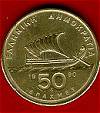 While the penteconter
was the
old-style ship from previous eras, the new fleet which Athens would turn against the
Persians at Salamis was primarily composed of triremes. Learn more about triremes.
To the left is the obverse of the modern Greek 50 drachma coin,
an homage to Greek ships of the past. While the penteconter
was the
old-style ship from previous eras, the new fleet which Athens would turn against the
Persians at Salamis was primarily composed of triremes. Learn more about triremes.
To the left is the obverse of the modern Greek 50 drachma coin,
an homage to Greek ships of the past. |
The
Battle of Thermopylae (480 BC) |
| Much like in antiquity,
Thermopylae (called "Hot Gates" because it marks a narrow passage beyond which
lie hot springs) is situated along the road from northern to central/southern Greece. In
fact, even though the topography has changed since antiquity (the sea used to be closer),
the National Road pretty much follows the same route Xerxes' Persians forces did. All
agree that the forces were not equally matched, although Herodotus' numbers cannot
be right: he would have us believe that several thousand Greeks stood against over 5
million Persians. It is more likely that the Persian forces numbered about 300,000 against
the Greek's 7-8000. |
| The
Persians were so disheartened after the first day of fighting that they had to be whipped
into action (literally) the next day. With the help of a Greek turncoat, the Persians were
able to side-step Greek (Phocian) precautionary measures and approach the actual pass in
force. The Spartan commander Leonides dismissed all allies present (from nearly every
Peloponnesian city) except the Thebans and his own band of 300 crack fighting men. The
hand-to-hand combat grew so bloody that it is said that Xerxes rose three times from his
throne in horror at the losses. Leonides and his band fought to the last man, the
surviving Thebans were captured, and the Persians resumed their advance on Athens. |
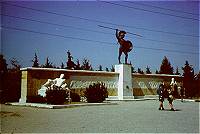 This
modern memorial to the men who died defending the pass at Thermopylae was erected in 1955
(and was funded by America!); the bronze statue of Leonides was modeled after a fifth
century marble statue presently housed This
modern memorial to the men who died defending the pass at Thermopylae was erected in 1955
(and was funded by America!); the bronze statue of Leonides was modeled after a fifth
century marble statue presently housed in the Sparta museum. The
marble base of the memorial is composed of reliefs showing scenes from the battle and
bronze plaques bearing famous epigrams inspired by this conflict (photo on right). in the Sparta museum. The
marble base of the memorial is composed of reliefs showing scenes from the battle and
bronze plaques bearing famous epigrams inspired by this conflict (photo on right). |
|
The
Battle of Salamis (480 BC) |
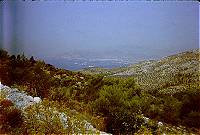 It is due to
Themistokles' powers of persuasion that the Athenians suffered
no loss of life when the Persians marched into Athens and burned it to the ground. The
Oracle of Delphi had warned that everything Athenian would be burned to the ground except
for what lay behind a wooden wall: some thought that meant that the populace should huddle
within the walls of the Acropolis and try to outlast a Persian siege. But Themistokles
rightly concluded that the "wooden wall" referred to the battleline of the great
Athenian warships. So when the Persians did march into Athens and burn down the city, the
women and children had already been transported safely to the nearby city of Troezen
(birthplace of Theseus), the old men were taken to the nearby island of Salamis, and only
those few who remained behind the walls lost their lives. It is due to
Themistokles' powers of persuasion that the Athenians suffered
no loss of life when the Persians marched into Athens and burned it to the ground. The
Oracle of Delphi had warned that everything Athenian would be burned to the ground except
for what lay behind a wooden wall: some thought that meant that the populace should huddle
within the walls of the Acropolis and try to outlast a Persian siege. But Themistokles
rightly concluded that the "wooden wall" referred to the battleline of the great
Athenian warships. So when the Persians did march into Athens and burn down the city, the
women and children had already been transported safely to the nearby city of Troezen
(birthplace of Theseus), the old men were taken to the nearby island of Salamis, and only
those few who remained behind the walls lost their lives. |
| See Herodotus (8:70-94) and
Aeschylus' play The Persians for ancient accounts of this battle. Scholars still
argue over the details, which can be pretty overwhelming, but the basic facts are these:
acting on false intelligence information planted by the Greeks, the Persians positioned
their fleet at the mouth of the Bay of Salamis, thinking to catch the Greek sailors before
they could man their ships in the morning. But dawn caught them walking right into a Greek
trap - as the Persian ships poured into the bay, the Greek ships, hiding in the channel
beyond the bay, rammed them broadside. The large number of Persian ships and the small
diameter of the bay made it difficult for the Persians to maneuver (one story in
particular tells of one Persian ship sinking another). The Greek victory at the Battle of
Salamis forced Xerxes to hightail it home, but the Persian threat wasn't over by a long
shot. |
|
The
Battle of Plataea (479 BC) |
| In the Battle of Plataea
(north of Athens, on the border between Attica and Boeotia), a combined Greek force (from
31 different city-states!) helped ward off the enemy Persians and their Greek allies the
Thebans, who had "medised" or "gone Persian" during these wars against
her own Greek brethren (it is probable that even Thebes' participation in the Battle of
Thermopylae was under duress - i.e., Leonides forced them to stay and defend the pass). In
this final battle of the Persian Wars, the Spartans killed the Persian general Mardonius
(whose sword is thereafter displayed in the Erechtheum on the Athenian
Acropolis as a spoil of war) and the Athenians decimated the Theban Sacred Band. |
| Fifty years later, though, Thebes will
exact retribution from the Athenian-allied Plataeans: theirs is one of the first cities
ravaged by Thebes in the 431 BC campaigns of the Peloponnesian War, the year of war
commemorated by Pericles in his famous Funeral Oration. And, of course, soon Athens and
Sparta will no longer be "Hellenic" allies fighting against a "foreign
aggressor," but enemies in their own right (as alluded to by Pericles in that same
speech). See Herodotus 9.19 for a full report on the 479 BC Battle of
Plataea.
|
|
The frieze of the
Temple of Athena Nike on the Acropolis (built during the Peloponnesian War) trumpets the
Athenian victory at that very Battle of Plataea - it is most remarkable for the frieze of
a Temple (especially one dedicated to Athena!) to relate an historical - not mythological -
battle. We are reminded that "Nike" means "Victory." |
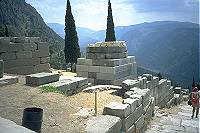 In Delphi we can
still today see the base of the Tripod of the Plataeans, erected to commemorate the
victory of the Greek city-states over the Persian army at Plataea in 479 BC
(Pausanias
X.13.9). The monument commands an important space, as it sits directly across the Sacred
Way from the Altar of the Temple of Apollo yet is not blocked by it. Originally a golden
victory tripod stood atop three twisted snake columns upon which were inscribed the names
of the 31 city-states who contributed to the victory. The Emperor Constantine the Great
(early 4th century AD) removed the columns to Constantinople, where half of it remains
today on display in the Hippodrome. In Delphi we can
still today see the base of the Tripod of the Plataeans, erected to commemorate the
victory of the Greek city-states over the Persian army at Plataea in 479 BC
(Pausanias
X.13.9). The monument commands an important space, as it sits directly across the Sacred
Way from the Altar of the Temple of Apollo yet is not blocked by it. Originally a golden
victory tripod stood atop three twisted snake columns upon which were inscribed the names
of the 31 city-states who contributed to the victory. The Emperor Constantine the Great
(early 4th century AD) removed the columns to Constantinople, where half of it remains
today on display in the Hippodrome.
copyright
2001 Janice
Siegel,
All Rights Reserved
send comments to: Janice Siegel (jfsiege@ilstu.edu)
date this page was edited last:
08/02/2005
the URL
of this page:
|
|
